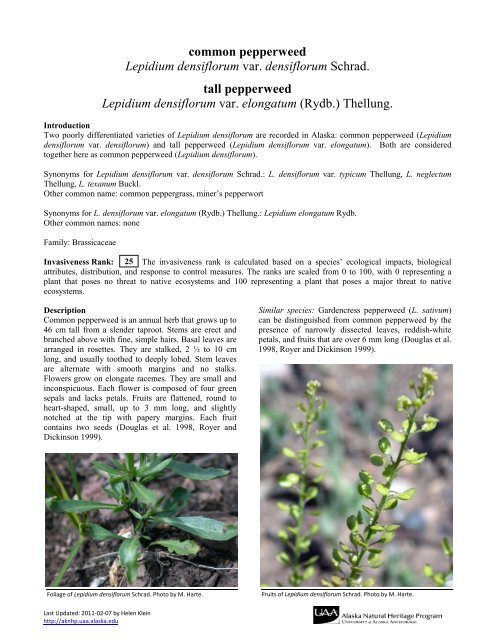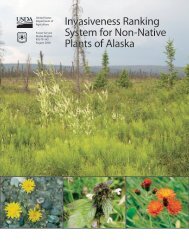common pepperweed Lepidium densiflorum - University of Alaska
common pepperweed Lepidium densiflorum - University of Alaska
common pepperweed Lepidium densiflorum - University of Alaska
You also want an ePaper? Increase the reach of your titles
YUMPU automatically turns print PDFs into web optimized ePapers that Google loves.
<strong>common</strong> <strong>pepperweed</strong><br />
<strong>Lepidium</strong> <strong>densiflorum</strong> var. <strong>densiflorum</strong> Schrad.<br />
tall <strong>pepperweed</strong><br />
<strong>Lepidium</strong> <strong>densiflorum</strong> var. elongatum (Rydb.) Thellung.<br />
Introduction<br />
Two poorly differentiated varieties <strong>of</strong> <strong>Lepidium</strong> <strong>densiflorum</strong> are recorded in <strong>Alaska</strong>: <strong>common</strong> <strong>pepperweed</strong> (<strong>Lepidium</strong><br />
<strong>densiflorum</strong> var. <strong>densiflorum</strong>) and tall <strong>pepperweed</strong> (<strong>Lepidium</strong> <strong>densiflorum</strong> var. elongatum). Both are considered<br />
together here as <strong>common</strong> <strong>pepperweed</strong> (<strong>Lepidium</strong> <strong>densiflorum</strong>).<br />
Synonyms for <strong>Lepidium</strong> <strong>densiflorum</strong> var. <strong>densiflorum</strong> Schrad.: L. <strong>densiflorum</strong> var. typicum Thellung, L. neglectum<br />
Thellung, L. texanum Buckl.<br />
Other <strong>common</strong> name: <strong>common</strong> peppergrass, miner’s pepperwort<br />
Synonyms for L. <strong>densiflorum</strong> var. elongatum (Rydb.) Thellung.: <strong>Lepidium</strong> elongatum Rydb.<br />
Other <strong>common</strong> names: none<br />
Family: Brassicaceae<br />
Invasiveness Rank: 25 The invasiveness rank is calculated based on a species’ ecological impacts, biological<br />
attributes, distribution, and response to control measures. The ranks are scaled from 0 to 100, with 0 representing a<br />
plant that poses no threat to native ecosystems and 100 representing a plant that poses a major threat to native<br />
ecosystems.<br />
Description<br />
Common <strong>pepperweed</strong> is an annual herb that grows up to<br />
46 cm tall from a slender taproot. Stems are erect and<br />
branched above with fine, simple hairs. Basal leaves are<br />
arranged in rosettes. They are stalked, 2 ½ to 10 cm<br />
long, and usually toothed to deeply lobed. Stem leaves<br />
are alternate with smooth margins and no stalks.<br />
Flowers grow on elongate racemes. They are small and<br />
inconspicuous. Each flower is composed <strong>of</strong> four green<br />
sepals and lacks petals. Fruits are flattened, round to<br />
heart-shaped, small, up to 3 mm long, and slightly<br />
notched at the tip with papery margins. Each fruit<br />
contains two seeds (Douglas et al. 1998, Royer and<br />
Dickinson 1999).<br />
Similar species: Gardencress <strong>pepperweed</strong> (L. sativum)<br />
can be distinguished from <strong>common</strong> <strong>pepperweed</strong> by the<br />
presence <strong>of</strong> narrowly dissected leaves, reddish-white<br />
petals, and fruits that are over 6 mm long (Douglas et al.<br />
1998, Royer and Dickinson 1999).<br />
Foliage <strong>of</strong> <strong>Lepidium</strong> <strong>densiflorum</strong> Schrad. Photo by M. Harte.<br />
Fruits <strong>of</strong> <strong>Lepidium</strong> <strong>densiflorum</strong> Schrad. Photo by M. Harte.<br />
Last Updated: 2011-02-07 by Helen Klein<br />
http://aknhp.uaa.alaska.edu
Ecological Impact<br />
Impact on community composition, structure, and<br />
interactions: Common <strong>pepperweed</strong> establishes in open<br />
disturbed sites in <strong>Alaska</strong> (UAM 2003, AKEPIC 2010).<br />
No impacts on native populations have been<br />
documented.<br />
Impact on ecosystem processes: Common <strong>pepperweed</strong><br />
has little or no effect on natural ecosystem processes<br />
(Densmore et al. 2001).<br />
Biology and Invasive Potential<br />
Reproductive potential: Common <strong>pepperweed</strong><br />
reproduces by seeds only. Each plant can produce up to<br />
5,000 seeds (Royer and Dickinson 1999).<br />
Role <strong>of</strong> disturbance in establishment: Infestations <strong>of</strong><br />
<strong>common</strong> <strong>pepperweed</strong> are usually associated with<br />
anthropogenic disturbances. Plants may appear on sites<br />
<strong>of</strong> previous human use, particularly when the soil is<br />
disturbed by construction or trampling (Densmore et al.<br />
2001).<br />
Potential for long-distance dispersal: At maturity, stems<br />
can break <strong>of</strong>f from the bases and tumble in the wind,<br />
spreading seeds (Rutledge and McLendon 1996).<br />
Potential to be spread by human activity: Common<br />
<strong>pepperweed</strong> is a weed <strong>of</strong> cultivated crops and can be<br />
spread as a contaminant in commercial seed (USDA<br />
2010).<br />
Germination requirements: Common <strong>pepperweed</strong><br />
requires disturbance and open soil to germinate<br />
(Densmore et al. 2001).<br />
Growth requirements: Common <strong>pepperweed</strong> grows best<br />
in light, sandy soils (Rutledge and McLendon 1996).<br />
Congeneric weeds: Field <strong>pepperweed</strong> (<strong>Lepidium</strong><br />
campestre), perennial <strong>pepperweed</strong> (L. latifolium),<br />
clasping <strong>pepperweed</strong> (L. perfoliatum), and roadside<br />
<strong>pepperweed</strong> (L. ruderale) are known to occur as nonnative<br />
weeds in North America (Royer and Dickinson<br />
1999, USDA 2010). Perennial <strong>pepperweed</strong> is considered<br />
a noxious weed in British Columbia and 13 states <strong>of</strong> the<br />
U.S. (Invaders 2010).<br />
Legal Listings<br />
Has not been declared noxious<br />
Listed noxious in <strong>Alaska</strong><br />
Listed noxious by other states<br />
Federal noxious weed<br />
Listed noxious in Canada or other countries<br />
Distribution and abundance<br />
Common <strong>pepperweed</strong> grows in disturbed areas,<br />
roadsides, waste areas, farmyards, and cultivated fields<br />
(Welsh 1974, Royer and Dickinson 1999).<br />
Native and current distribution: Common <strong>pepperweed</strong><br />
is native to North America, but may have been<br />
introduced recently into <strong>Alaska</strong> and Yukon (Hultén<br />
1968, Cody 2000). Common <strong>pepperweed</strong> grows in<br />
Canada, the U.S., and Europe (Hultén 1968). This<br />
species has been documented from the Pacific Maritime<br />
and Interior-Boreal ecogeographic regions <strong>of</strong> <strong>Alaska</strong><br />
(Hultén 1968, UAM 2003, AKEPIC 2010).<br />
Pacific Maritime<br />
Interior-Boreal<br />
Arctic-Alpine<br />
Collection Site<br />
Distribution <strong>of</strong> <strong>common</strong> <strong>pepperweed</strong> in <strong>Alaska</strong><br />
Management<br />
Common <strong>pepperweed</strong> can be controlled easily by hand<br />
pulling or herbicide applications. Due to the large, longlived<br />
seed banks, several treatments may be necessary to<br />
completely remove populations (Densmore et al. 2001).<br />
References:<br />
AKEPIC database. <strong>Alaska</strong> Exotic Plant Information<br />
Clearinghouse Database. 2010. Available:<br />
http://akweeds.uaa.alaska.edu/<br />
Cody, W.J. 2000. Flora <strong>of</strong> the Yukon Territory. Ottawa:<br />
NRC Research Press; 669 p.<br />
Densmore, R. V., P. C. McKee, C. Roland. 2001. Exotic<br />
plants in <strong>Alaska</strong>n National Park Units. Report<br />
on file with the National Park Service – <strong>Alaska</strong><br />
Region, Anchorage, <strong>Alaska</strong>. 143 pp.<br />
Douglas, G. W., G. B. Straley, D. Meidinger, J. Pojar.<br />
1998. Illustrated flora <strong>of</strong> British Columbia. V.<br />
2. Ministry <strong>of</strong> Environment, Lands and Parks<br />
Ministry <strong>of</strong> Forests. British Columbia. 401 pp.<br />
Hultén, E. 1968. Flora <strong>of</strong> <strong>Alaska</strong> and Neighboring<br />
Territories. Stanford <strong>University</strong> Press, Stanford,<br />
CA. 1008 p.<br />
Invaders Database System. 2010. <strong>University</strong> <strong>of</strong><br />
Montana. Missoula, MT.<br />
http://invader.dbs.umt.edu/<br />
Royer, F., and R. Dickinson. 1999. Weeds <strong>of</strong> the<br />
Northern U.S. and Canada. The <strong>University</strong> <strong>of</strong><br />
Alberta press. 434 pp.<br />
Rutledge, C.R., and T. McLendon. 1996. An<br />
Assessment <strong>of</strong> Exotic Plant Species <strong>of</strong> Rocky<br />
Mountain National Park. Department <strong>of</strong><br />
Rangeland Ecosystem Science, Colorado State<br />
Last Updated: 2011-02-07 by Helen Klein<br />
http://aknhp.uaa.alaska.edu
<strong>University</strong>. 97 pp. Northern Prairie Wildlife<br />
Research Center Home Page.<br />
http://www.npwrc.usgs.gov/resource/plants/exp<br />
lant/index.htm (Version 15DEC98).<br />
UAM. 2003. <strong>University</strong> <strong>of</strong> <strong>Alaska</strong> Museum. <strong>University</strong><br />
<strong>of</strong> <strong>Alaska</strong> Fairbanks. http://hispida.museum.uaf.<br />
edu:8080/home.cfm<br />
USDA. 2010. The PLANTS Database. National Plant<br />
Data Center, Natural Resources Conservation<br />
Service, United States Department <strong>of</strong><br />
Agriculture. Baton Rouge, LA.<br />
http://plants.usda.gov<br />
Welsh, S. L. 1974. Anderson’s flora <strong>of</strong> <strong>Alaska</strong> and<br />
adjacent parts <strong>of</strong> Canada. Brigham <strong>University</strong><br />
Press. 724 pp.<br />
Last Updated: 2011-02-07 by Helen Klein<br />
http://aknhp.uaa.alaska.edu

















